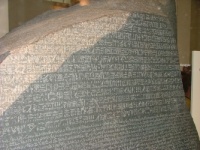Rosetta Stone (196 BC)
A Valuable Key to the Decipherment of Hieroglyphs[edit]
The inscription on the Rosetta Stone is a decree passed by a council of priests on behalf of Ptolemy V on the first anniversary of his coronation. This decree is inscribed on the stone three times, in hieroglyphic (for important or religious documents), demotic (the common script of Egypt) and Greek (the language of Egyptian rulers at the time). The significance of this decree, written three times, is monumental. Thomas Young, an English physicist was the first to find that there was a pattern to these three inscriptions. He discovered that some of the hieroglyphs wrote the sounds of a royal name: Ptolemy. Jean-François Champollion, a French scholar, soon found that the hieroglyphs recorded the sound of the Egyptian language. This has been a hugely important discovery in the history of etymology and is a fantastic example of cultural diplomacy because it has informed our understanding of ancient Egyptian language and culture. The Rosetta Stone was carved in 196 BC and was found in 1799 in a small village in the Delta names Rosetta (Rashid). The Rosetta Stone has been on display at the British Museum since 1802 and is the most visited artefact in the museum.
